This paper discusses the design and implementation of a digital filter bank aimed at reducing noise from composite signals and reconstructing original input signals using FIR filters. The process involves creating a composite signal from three sinusoidal signals, adding noise, and then employing a FIR digital filter bank to extract the original signals. The study illustrates the methodology with MATLAB simulations, highlighting the significance of filter banks in noise reduction and signal reconstruction.
![Signal & Image Processing : An International Journal (SIPIJ) Vol.6, No.2, April 2015
DOI : 10.5121/sipij.2015.6202 15
DESIGN AND IMPLEMENTATION OF DIGITAL
FILTER BANK TO REDUCE NOISE AND
RECONSTRUCT THE INPUT SIGNALS
Kawser Ahammed1
, Md. Ershadullah2
, Md. Rakebul Islam Heru3
, Saiful Islam4
and Dr. Z. M. Parvez Sazzad5
1,2,3,4
Department of Electrical & Electronic Engineering (Former Applied Physics,
Electronics & Communication Engineering),
University of Dhaka, Dhaka, Bangladesh
5
Professor, Department of Electrical & Electronic Engineering,
University of Dhaka, Dhaka, Bangladesh
ABSTRACT
The main theme of this paper is to reduce noise from the noisy composite signal and reconstruct the input
signals from the composite signal by designing FIR digital filter bank. In this work, three sinusoidal signals
of different frequencies and amplitudes are combined to get composite signal and a low frequency noise
signal is added with the composite signal to get noisy composite signal. Finally noisy composite signal is
filtered by using FIR digital filter bank to reduce noise and reconstruct the input signals.
KEYWORDS
Digital Filter Bank, Noise, LMS Filter, LMS Algorithm, Composite Signal
1. INTRODUCTION
Over the past two decades, the research on efficient design of filter banks has received
considerable attention in numerous fields such as speech coding, scrambling, image processing
etc. [1-2]. At the same time design of filter banks has received attention on noise reduction. So
noises in any digital signals significantly hamper the actual performance of signals at the desired
output [3-4]. So filter banks are required to reduce these noises. A filter bank is nothing but a
group of parallel low pass, band pass and high pass filters [5] that separate the input signal into
multiple components, each one carrying a single frequency subband of the original signal [6]. The
process of decomposition performed by the filter bank is called analysis. The reconstruction
process is called synthesis, meaning reconstitution of a complete signal resulting from the
filtering process [7]. Filter banks are generally classified as two types, analysis filter banks and
synthesis filter banks [8]. An analysis filter bank comprises of filters, with system transfer
functions {Hk(z)}, where k= 0, 1, …. , M-1; arranged in a parallel bank as shown in Figure 1. On
the contrary, a synthesis filter bank comprises of a set of filters with system transfer functions
{Gk(z)} , where k= 0, 1, … , M-1; arranged as shown in Figure 2, with corresponding inputs
{yk(m)}.The outputs of the filters are summed to form the synthesized signal ݔ(݊). The blocks
with arrows pointing downwards in Figure1 indicate down sampling by factor N, and the blocks
with arrows pointing upwards in Figure 2 indicate up sampling by N.](https://image.slidesharecdn.com/6215sipij02-150508084942-lva1-app6891/75/D-ESIGN-A-ND-I-MPLEMENTATION-OF-D-IGITAL-F-ILTER-B-ANK-T-O-R-EDUCE-N-OISE-A-ND-R-ECONSTRUCT-T-HE-I-NPUT-S-IGNALS-1-2048.jpg)
![Signal & Image Processing : An International Journal (SIPIJ) Vol.6, No.2, April 2015
16
Analysis Filter Bank Subband
signals
ݕ(݉)
ݕଵ(݉)
x(n) . .
. .
. .
ݕெିଵ(݉)
Figure 1. Analysis filter bank, adapted from Ref. [1]
Sub sampling by N means that only every N-th sample is taken. This operation serves to reduce
or eliminate redundancies in the M subband signals. Up sampling by N means the insertion of N-
1 consecutive zeros between the samples. This allows us to recover the original sampling rate.
There are many applications of filter banks such as graphic equalizer, signal compression, bank of
receiver, noise reduce etc.
Subband Synthesis Filter Bank
signals
ݕ(݉)
ݕଵ(݉) ݔ(݊)
. .
. .
. .
ݕெିଵ(݉)
Figure 2. Synthesis filter bank, adapted from Ref. [1]
2. EXAMPLE OF A FILTER BANK
In this section, a two channel filter bank adapted from ref. [9] has been described. Figure 3 shows
such kind of two channel filter bank. It is convenient to analyse the filter bank in the Z-domain.
Therefore, by using Z-transform the expressions for the various intermediate signals in figure 3
are given by
ܴ(ݖ) = ܪ(ݖ)ܷ(ݖ) (1)
ܵ(ݖ) =
1
2
൜ܴ ൬ݖ
ଵ
ଶ൰ + ܴ ൬−ݖ
ଵ
ଶ൰ൠ (2)
ܪ()ݖ N ↓
ܪଵ()ݖ
ܪெିଵ()ݖ
N ↓
N ↓
ܩ()ݖN ↑
ܩଵ()ݖ
ܩெିଵ()ݖ
N ↑
N ↑](https://image.slidesharecdn.com/6215sipij02-150508084942-lva1-app6891/75/D-ESIGN-A-ND-I-MPLEMENTATION-OF-D-IGITAL-F-ILTER-B-ANK-T-O-R-EDUCE-N-OISE-A-ND-R-ECONSTRUCT-T-HE-I-NPUT-S-IGNALS-2-2048.jpg)
![Signal & Image Processing : An International Journal (SIPIJ) Vol.6, No.2, April 2015
17
ܹ(ݖ) = ܵ(ݖଶ) (3)
for l=0,1. After performing some algebra, the following equation is obtained
ܹ()ݖ =
1
2
ሼܴ()ݖ + ܴ(−})ݖ =
1
2
ሼܪ()ݖ ܷ()ݖ + ܪ(−)ݖ ܷ(−ܼ) } (4)
Now the reconstructed output of the filter bank is attained by
ܸ(ݖ) = ܩ(ݖ)ܹ(ݖ) + ܩଵ(ݖ) ܹଵ(ݖ) (5)
Substituting equation (4) in equation (5), the output of the filter bank is obtained by
ܸ()ݖ =
1
2
ሼܪ(ܩ)ݖ()ݖ + ܪଵ(ܩ)ݖଵ(})ݖ ܷ()ݖ +
1
2
ሼܪ(−ܩ)ݖ()ݖ
+ ܪଵ(−ݖ)ܩଵ(ݖ)} ܷ(−)ݖ (6)
The first term in the above equation describes the transmission of the signal U (z) through
the system, while the second term describes the aliasing component at the output. The
above equation can be compactly represented as
ܸ(ݖ) = ܦ(ݖ)ܷ(ݖ) + ܤ(ݖ)ܷ(−ݖ) (7)
Where ܦ(ݖ) =
ଵ
ଶ
ሼܪ(ݖ)ܩ(ݖ) + ܪଵ(ݖ)ܩଵ(ݖ)}ܷ(ݖ) (8)
is called the distortion transfer function, and
)ݖ(ܤ =
1
2
ሼܪ(−ܩ)ݖ(ݖ) + ܪଵ(−ݖ)ܩଵ(ݖ)}ܷ(−)ݖ (9)
r0 (n) s0 (n) w0 (n)
u(n) v(n)
r1 (n) s1 (n) w1 (n)
Figure 3. Two channel filter bank, adapted from Ref. [1]
3. METHODOLOGY
At the first step, amplitude, frequency and sample time of three sinusoidal signals, denoted by A1,
B1 and C1, are fixed to form composite signal and a random source is considered to get random
signal. The random source acts as a noise source. The block parameters of three sinusoidal signals
are shown in Figure 4.
2↓ܪ()ݖ 2↑
2↑2↓ܪଵ()ݖ ܩଵ()ݖ
ܩ()ݖ](https://image.slidesharecdn.com/6215sipij02-150508084942-lva1-app6891/75/D-ESIGN-A-ND-I-MPLEMENTATION-OF-D-IGITAL-F-ILTER-B-ANK-T-O-R-EDUCE-N-OISE-A-ND-R-ECONSTRUCT-T-HE-I-NPUT-S-IGNALS-3-2048.jpg)
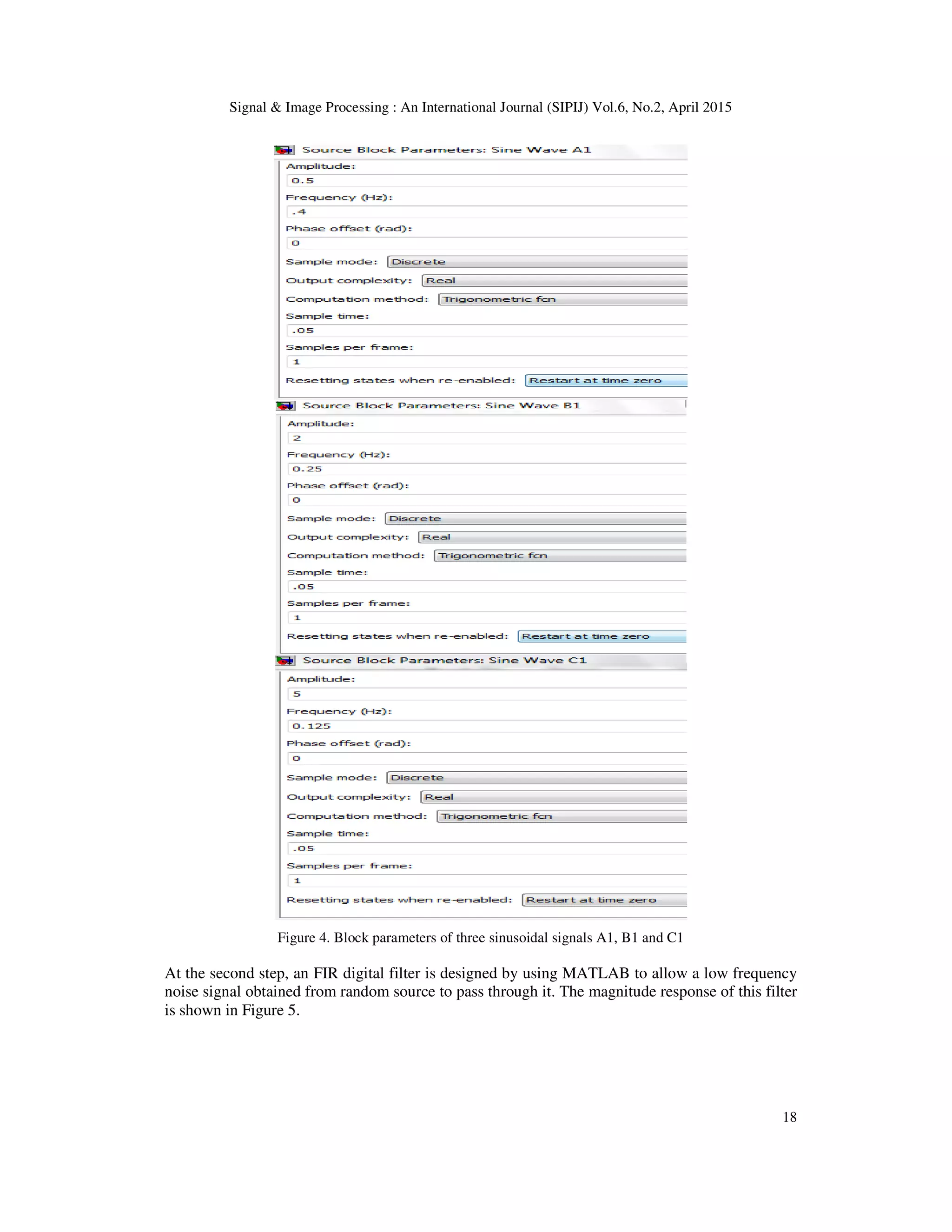
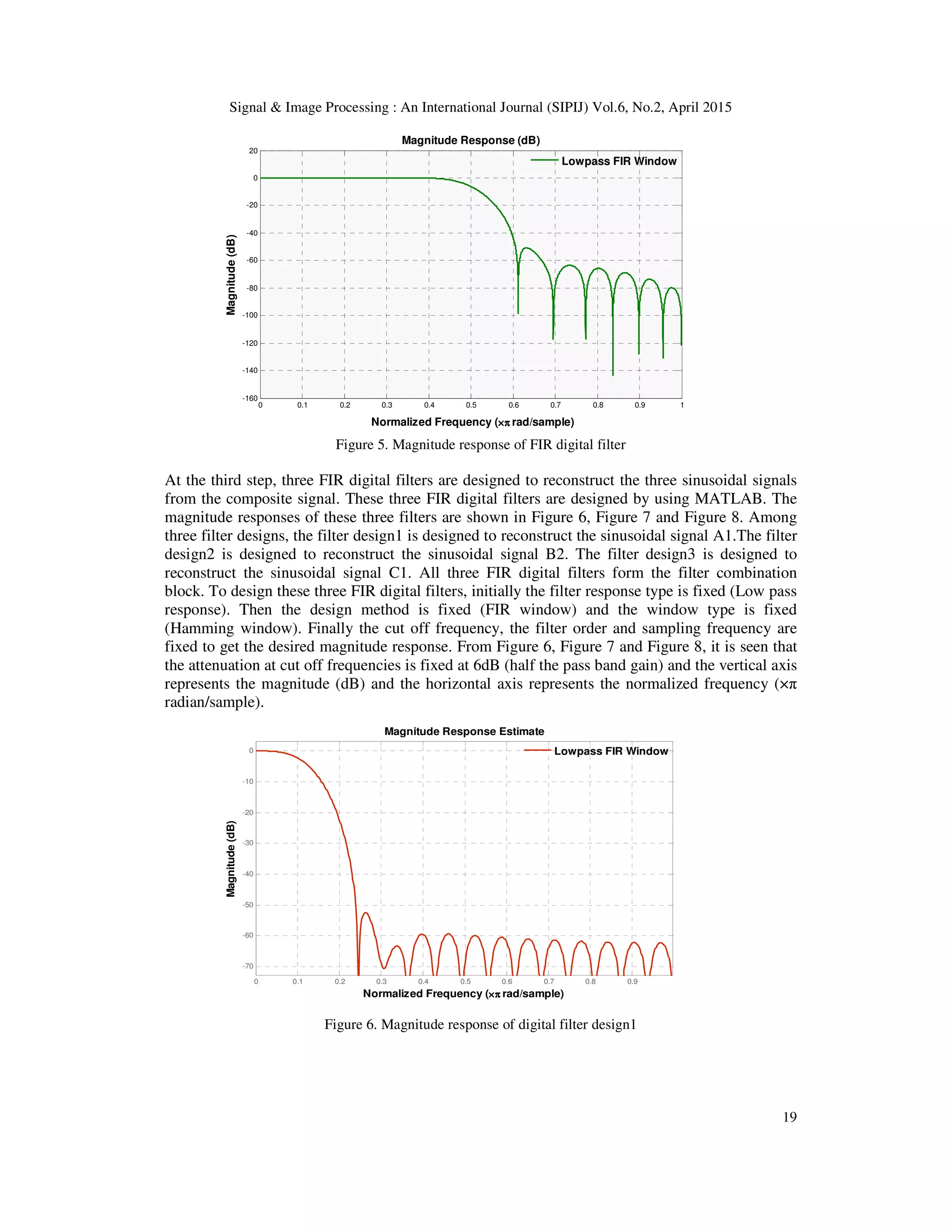
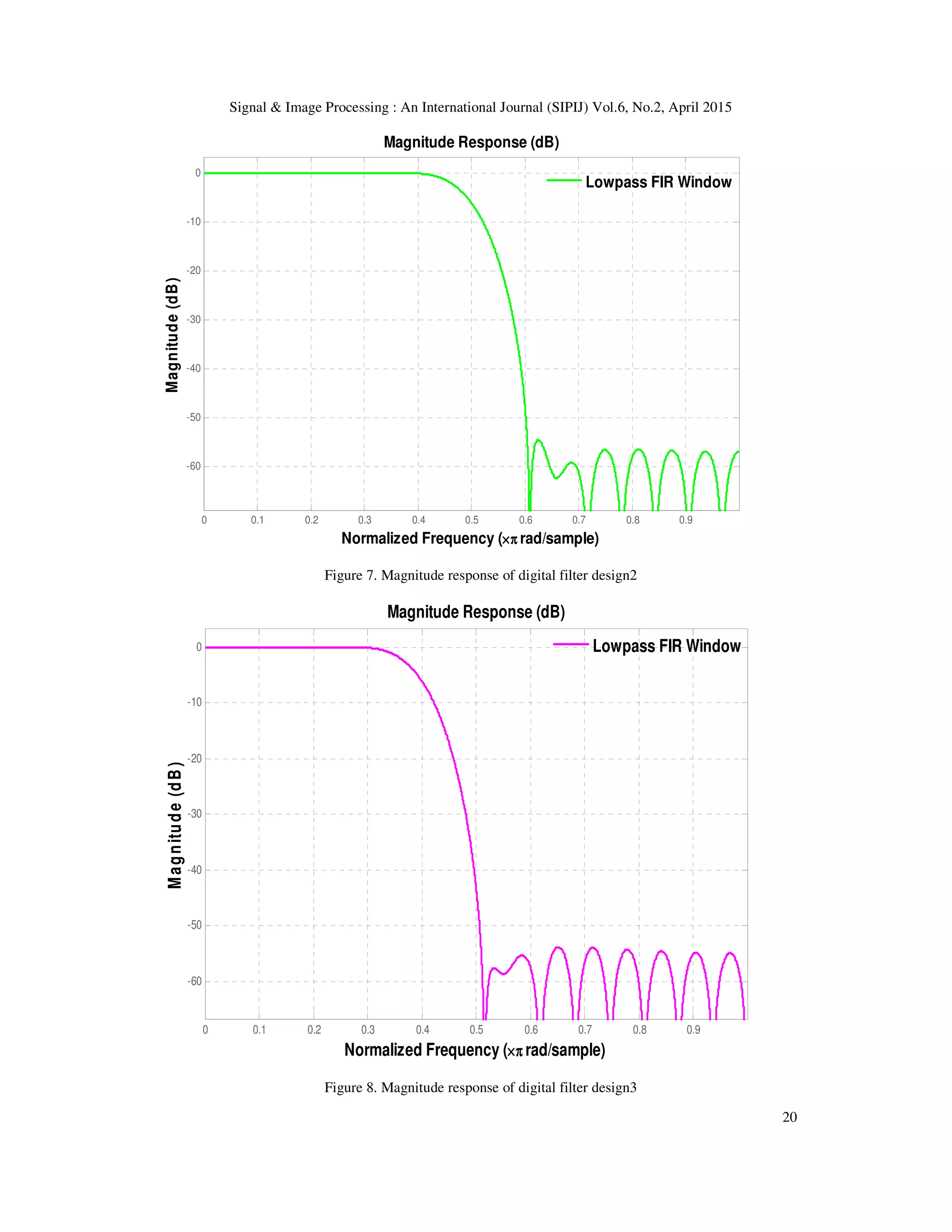
![Signal & Image Processing : An International Journal (SIPIJ) Vol.6, No.2, April 2015
21
Figure 9. Simulation block diagram to reduce noise and reconstruct the input signals
3.1. LMS FILTER
The LMS Filter block, shown in Figure 9, can implement an adaptive FIR filter using five
different algorithms. The block estimates the filter weights, or coefficients, needed to minimize
the error between the output signal and the desired signal [10]. Connect the signal which I want to
filter to the Input port. This input signal can be a sample-based scalar or a single-channel frame-
based signal. Connect the desired signal to the desired port. The desired signal must have the
same data type, frame status, complexity, and dimensions as the input signal. The Output port
outputs the filtered input signal, which is the estimate of the desired signal. The output of the
Output port has the same frame status as the input signal. The Error port outputs the result of
subtracting the output signal from the desired signal [11]. An important general form for adaptive
filters is the Least Mean Square (LMS) filter. Consider the N-th order FIR filter,
yn=h(1)xn-1+h(2)xn-2+……..+h(n)xn-N (10)
the filter error is,
e (n)=xn - yn (11)
The LMS filter adjusts the values of the coefficients, h, proportional to the error, e
hi(n) = hi-1(n)+2µxn-i en (12)
where µ is a learning factor which controls how strongly the error is weighted. This equation is
the consequence of the requirement to minimize mean square value of , e ,hence the name of the
filter [12].](https://image.slidesharecdn.com/6215sipij02-150508084942-lva1-app6891/75/D-ESIGN-A-ND-I-MPLEMENTATION-OF-D-IGITAL-F-ILTER-B-ANK-T-O-R-EDUCE-N-OISE-A-ND-R-ECONSTRUCT-T-HE-I-NPUT-S-IGNALS-7-2048.jpg)
![Signal & Image Processing : An International Journal (SIPIJ) Vol.6, No.2, April 2015
22
3.2 LMS ALGORITHM
The least mean squares (LMS) algorithms adjust the filter coefficients to minimize the cost
function. So LMS algorithm is important because of its simplicity and ease of computation [13].
The standard LMS algorithm performs the following operations to update the coefficients of an
adaptive filter:
• Calculates the output signal y(n) from the adaptive filter
• Calculates the error signal e (n) by using the following equation [14]: e (n) = d (n) – y
(n); d(n)= desired signal
• Updates the filter coefficients by using the following equation [15]:
ݓෝ(݊ + 1) = ݓෝ(݊) + ߤ. ݁(݊). ݑො(݊) (13)
Where µ is the step size of the adaptive filter, ݓෝ(n) is the filter coefficients vector, and ݑො(݊) is the
filter input vector. The normalized LMS (NLMS) algorithm is a modified form of the standard
LMS algorithm [16]. The NLMS algorithm updates the coefficients of an adaptive
filter by using the following equation:
ݓෝ(݊ + 1) = ݓෝ(݊) + ߤ. ݁(݊).
௨ෝ()
∥ ௨ෝ()∥మ (14)
3.3 FILTER DESIGN AND ANALYSIS TOOL (FDA Tool)
The Filter Design and Analysis Tool (FDA Tool) is a powerful user interface for designing and
analyzing filters swiftly. FDA Tool enables to design digital FIR or IIR filters by setting filter
specifications, by importing filters from MATLAB workspace, or by adding, moving or deleting
poles and zeros. FDA Tool also provides tools for analyzing filters, such as magnitude and phase
response and pole-zero plots [17].
3.4 VECTOR SCOPE
The Vector Scope block is a comprehensive display tool similar to a digital oscilloscope. The
block can display time-domain, frequency-domain, or user-defined signals. The input to the
Vector Scope block can be any real-valued M-by-N matrix, column or row vector, or 1-D
(Dimensional) vector, where 1-D vectors are treated as column vectors. Regardless of the input
frame status, the block treats each column of an M-by-N input as an independent channel of data
with M consecutive samples [18].
3.5 OPERATION OF SIMULATION BLOCK DIAGRAM
Consider three sinusoidal signals A1, B1 and C1 as shown in Figure6. Let the amplitudes of A1,
B1and C1 are 0.5, 2 and 5 respectively and the frequencies are 0.4Hz, 0.25Hz and 0.125Hz
respectively. These three sinusoidal signals are combined applying superposition principle by
adder block. The output of the adder block is a composite signal. The composite signal is now
applied at the input of two input sum block and the vector scope input. A random source produces
a random signal (noise signal) and the random signal is applied at the input of a LMS filter. At the
same time the random signal is passed through a digital filter that produces a low frequency noise
signal. The low frequency noise signal is then applied at the desired input of the LMS filter and at
the input of the sum block. The output of the sum block is a noisy composite signal and applied at
the input of other sum block and vector scope input. The output of the LMS filter is then applied
at the sum block input. The output of the sum block is the noiseless composite signal. The three
sinusoidal signals are reconstructed by applying digital filter bank that is shown in Figure 10.](https://image.slidesharecdn.com/6215sipij02-150508084942-lva1-app6891/75/D-ESIGN-A-ND-I-MPLEMENTATION-OF-D-IGITAL-F-ILTER-B-ANK-T-O-R-EDUCE-N-OISE-A-ND-R-ECONSTRUCT-T-HE-I-NPUT-S-IGNALS-8-2048.jpg)
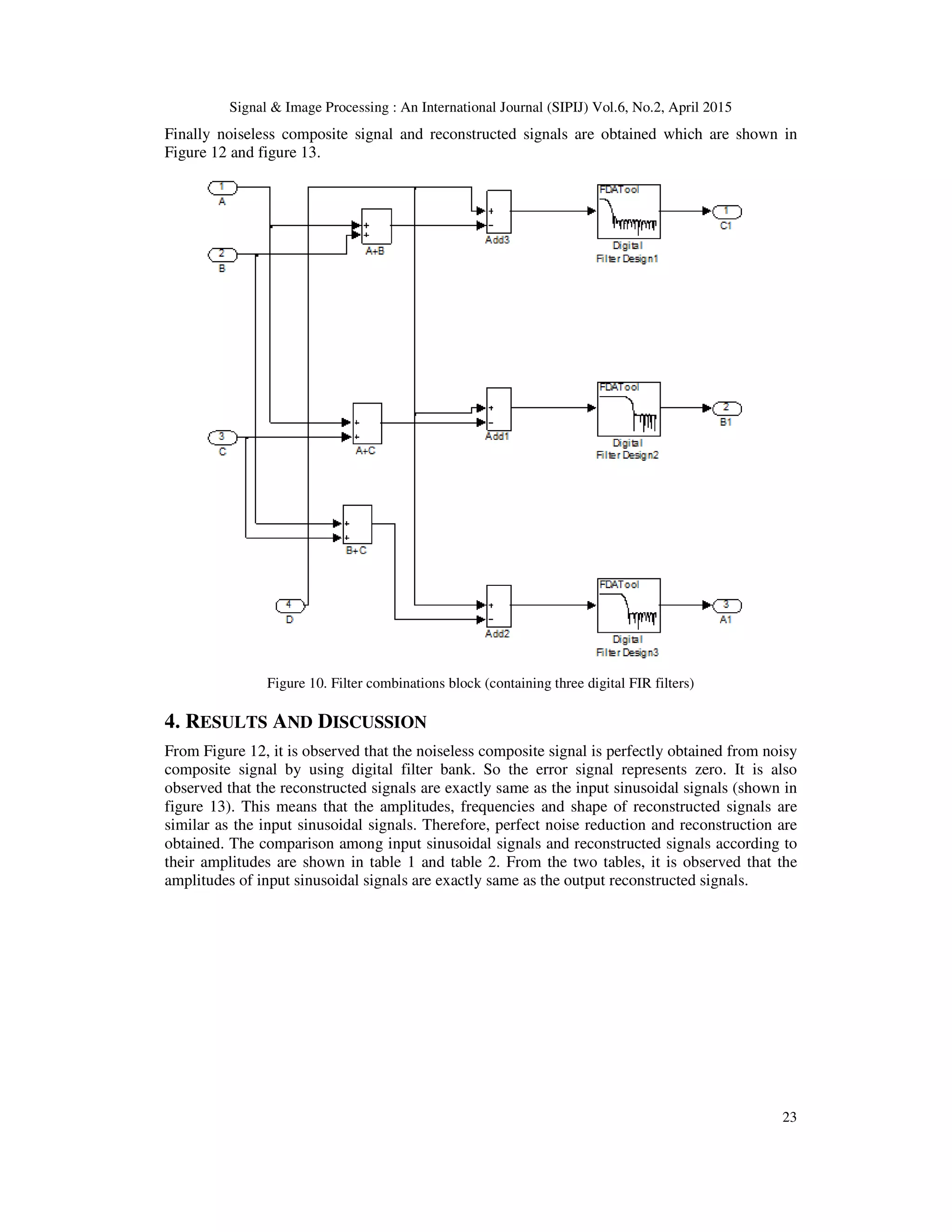
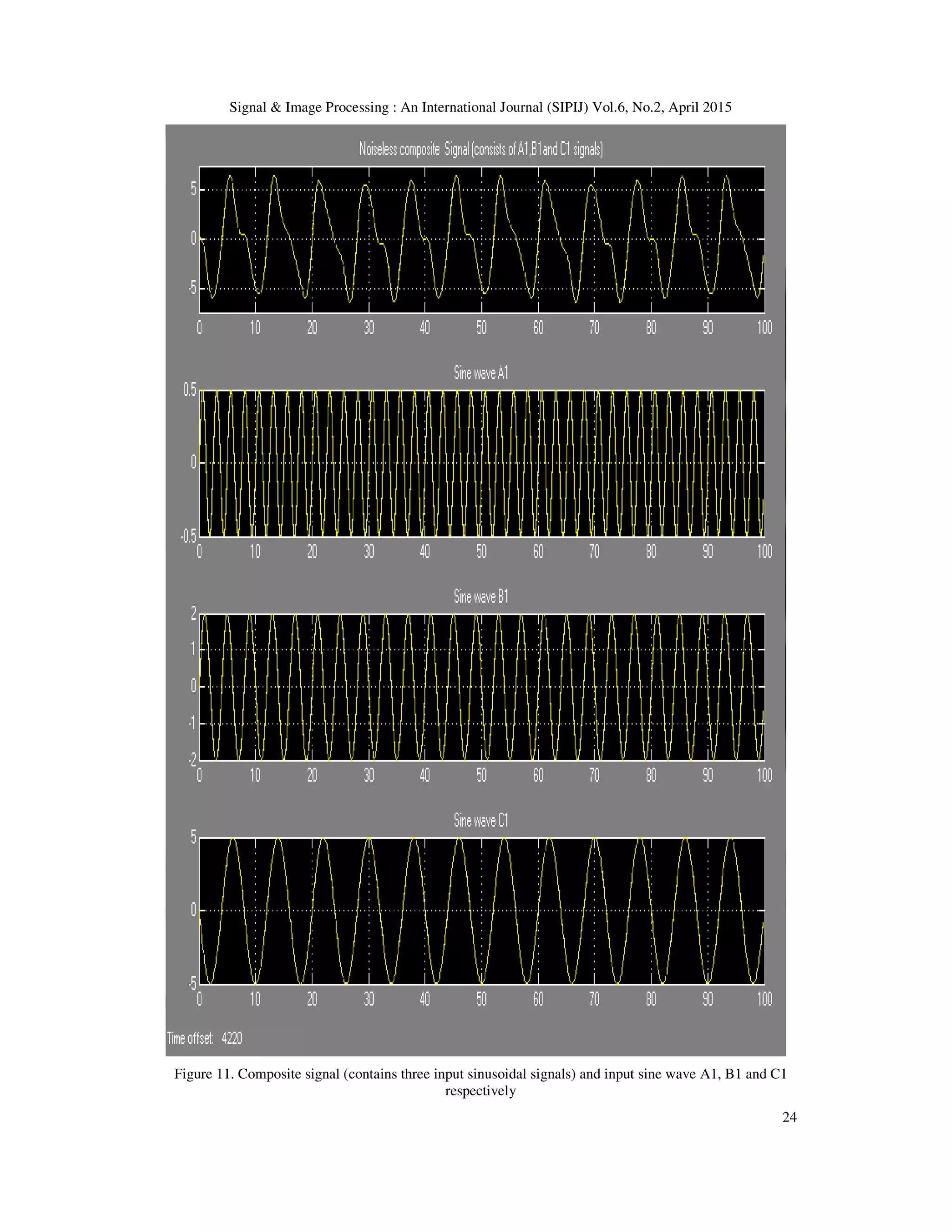

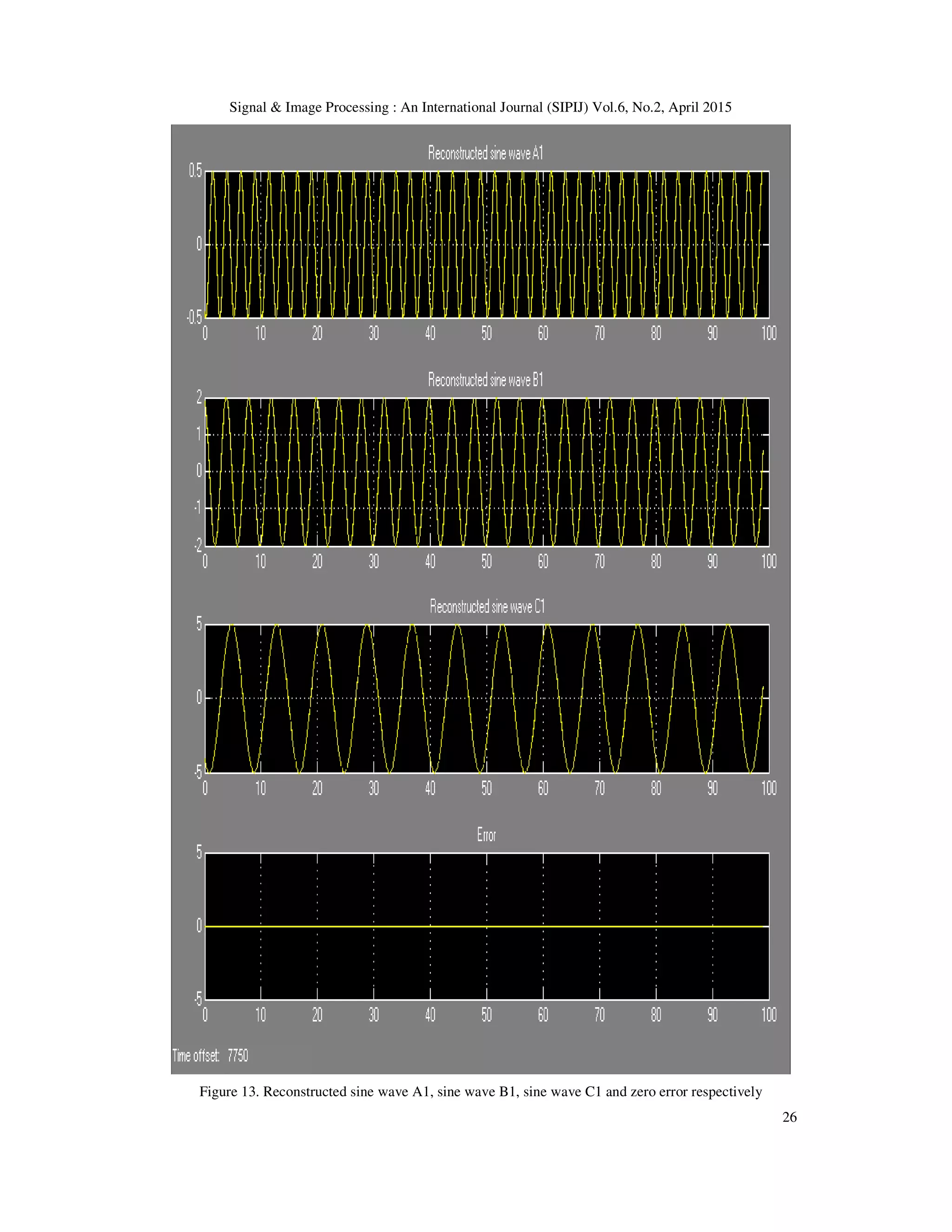
![Signal & Image Processing : An International Journal (SIPIJ) Vol.6, No.2, April 2015
27
5. CONCLUSION
Design and implementation of digital filter bank have been done in this paper to reduce noise and
reconstruct the input signals. This new process represents a significant improvement over analog
filters that also reduce noises. Among the different tasks of digital filter bank, only one task is
shown in this paper which is noise removal. In future work, I will try to implement others work of
digital filter bank and invent new work over digital filter bank.
REFERENCES
[1] A. Kumar G.K. Singh & R. S. Anand (May 2009) “Design of Quadrature Mirror Filter Bank Using
Particle Swam Optimization (PSO)”, International Journal of Recent Trends in Engineering, Vol. 1,
No. 3, pp. 213-214.
[2] Suverna dengar, Dr. Partha Pratim & Bhattacharya (Jan. - March 2012) “Design and Performance
Evaluation of a Quadrature Mirror Filter (QMF) Bank”, International Journal of Electronics &
Communication Technology, Vol. 3, Issue 1, pp. 209-210, ISSN: 2230-7109 (online) , ISSN: 2230-
9543 (print).
[3] Cheng, Abdulla, W.; Salcic, Z. (March 2011) “Hardware -Software Codesign of Automation Speech
Recognition System for Embedded Real-Time Applications”, Industrial Electronics, IEEE
Transactions on, Vol. 58, No. 3, pp. 850-859, doi: 10.1109/2009.2022520.
[4]E.S Kasthuri & A.P. James (October 2012) “Speech Filters for Speech Signal Noise Reduction”,
International Journal of Computer Applications (0975-8887), Vol. 55, No. 18 , pp. 1-2.
[5] S. Senthurpriya & Jagadeeswari (April 2012) “An efficient Design of Non-Uniform Filter Bank for
Digital Hearing Aids”, Internaional Journal of Emerging trends in Engineering & Development, Vol.
3, Issue 2, ISSN: 2249-6149.
[6] Alfred Mertins, “Signal Analysis: Wavelets, Filter Bank, Time Frequency, Transform and
Application”, Chapter 6, pp. 144-145, copyright © 1999, John wiley and Sons Ltd, Print ISBN 0471-
98626-7 Electronic ISBN 0-470-84183-4.
[7] Anamika Jain & Aditya Goel (August 2012) “Design of M Channel Perfect Reconstruction CMFB
Fiter Bank for Image Compression”, International Journal of Science & Engineeing Research, Vol. 3,
Issue 8, pp. 1-2, ISSN 2229-5518.
[8] John G. Prokis, Dimitris G. Manolakis, “In Digital Signal Processing Principles, Algorithms and
Applications”, Chapter 11, pp. 790-791, 4th edition.
[9] Sanjit K Mitra, “Digital Signal Processing A Coputer Based Approach”, Chapter 14, pp. 806-807, 3rd
edition.
[10] Asit Kumar Subudhi, Biswajit Mishra & Mihir Narayan Mohanty (2011) “VLSI Design and
Implementation for Adaptive Filter Using LMS Algorithm”, International Journal of Computer &
Communication Technology ( IJCCT) , Vol. 2, Issue 6, pp. 86-87.
[11] www.mathworks.com › ... › DSP Modeling › Scopes and Data Logging
[12] http://www.taygeta.com/papers/number9/node5.html](https://image.slidesharecdn.com/6215sipij02-150508084942-lva1-app6891/75/D-ESIGN-A-ND-I-MPLEMENTATION-OF-D-IGITAL-F-ILTER-B-ANK-T-O-R-EDUCE-N-OISE-A-ND-R-ECONSTRUCT-T-HE-I-NPUT-S-IGNALS-13-2048.jpg)
![Signal & Image Processing : An International Journal (SIPIJ) Vol.6, No.2, April 2015
28
[13] Ch. Santhi Rani, Dr. P. V. Subbaiah & Dr. K. Chennakesava Reddy (Sep.-December 2008) “LMS and
RLS Algorithms for Smart Antennas in a CDMA Mobile Communication Environment”,
International Journal of the Computer, the Internet Management, Vol. 16, No. 3, pp. 16.
[14] A. Bhavani Sankar, D. Kumar & K. Seethalakshmi, “Performance Study of Various Adaptive Filter
Algorithms for Noise Cancellation in Respiratory Signals”, Signal Processing: An International
Journal ( SPIJ), Vol. 4, Issue 5, pp. 271-272.
[15] Ajjaiah H.B.M, P.V. Hunagund, Manoj Kumar Singh & P.V. Rao. (2012) “Adaptive Variable Step
Size in LMS Algorithm Using Evolutionary Programming: VSSLMSEV”, Signal Processing: An
International Journal (SPIJ), Vol. 6, Issue 2, pp. 78-79.
[16] http://sine.ni.com/nips/cds/view/p/lang/en/nid/205382
[17] www.mathworks.com/products/.../examples.html?.../introfdatooldem
[18] http://www.mathworks.com/help/dsp/ref/lmsfilter.html
AUTHORS
Kawser Ahammed received B.Sc. degree in Applied Physics, Electronics &
Communication Engineering and MS degree in Applied Physics, Electronics &
Communication Engineering from University of Dhaka, Dhaka, Bangladesh, in 2011
and 2012 respectively. He has published 3 international research papers. His research
interests are in the areas of Signal Processing, Image Processing and Communications.
He is currently trying to pursue a Doctoral Degree in Electrical Engineering from USA.
Md. Ershadullah received B.Sc. degree in Applied Physics, Electronics &
Communication Engineering from University of Dhaka, Dhaka, Bangladesh, in 2011.
Now he is working as a Senior System Engineer in MAKS Renewable Energy
Company Limited, Bangladesh. In previous he worked as a Design & Service Engineer
in Solar Intercontinental (Solar-IC) Limited, Bangladesh.
Md. Rakebul Islam Heru received B.Sc. in Applied Physics, Electronics &
Communication Engineering from University of Dhaka, Dhaka, Bangladesh, in 2011.
Now he is working as an Assistant Maintenance Engineer at IT operation &
Communication Department in Bangladesh Bank (Central Bank of Bangladesh).
Saiful Islam is a B.Sc. final year student of Electrical & Electronic Engineering,
University of Dhaka, Dhaka, Bangladesh. His research interests are in the areas of
Biomedical image processing and Signal processing. At present, he is pursuing his
B.Sc. final year project work in National Institute of Nuclear Medicine and Allied
Sciences, BSMMU Campus, Shahbag, Dhaka, Bangladesh.
Dr. Z. M. Parvez Sazzad received B.Sc. degree in Applied Physics & Electronics and
MS degree in Applied Physics & Electronics from University of Dhaka, Dhaka,
Bangladesh, in 1993 and 1994 respectively. He received his PhD program from
Graduate School of Science and Engineering, University of Toyama, Japan, on March,
in 2008. He also received Post-Doc from Japan and France. He is currently working as
a Professor at Department of Electrical & Electronic Engineering (Former Applied
Physics, Electronics & Communication Engineering) in University of Dhaka, Dhaka,
Bangladesh. He has published 40 more papers in National and international journals and conferences. His
research interests are in the areas of Image / Video quality, Image/Video Compression, Image analysis and
segmentation, Motion Estimation, Biomedical image processing, Stereoscopic or multiview imaging,
Multimedia communication and broadcasting.](https://image.slidesharecdn.com/6215sipij02-150508084942-lva1-app6891/75/D-ESIGN-A-ND-I-MPLEMENTATION-OF-D-IGITAL-F-ILTER-B-ANK-T-O-R-EDUCE-N-OISE-A-ND-R-ECONSTRUCT-T-HE-I-NPUT-S-IGNALS-14-2048.jpg)